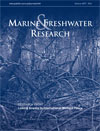
Marine and Freshwater Research
Volume 65 Number 7 2014
RESEARCH FRONT: Linking Science to International Wetland Policy – the Ramsar Convention on Wetlands
MF13006Recognising wetland ecosystem services within urban case studies
Within urban areas, wetlands provide a disproportionate amount of benefits upon which society depends. An analysis of case studies demonstrates that even in the most environmentally aware locations, the ecosystem services provided by wetlands, and other ecosystems, are under-recognised. To maintain human well-being in an increasingly urbanised world will require better planning and integration of ecosystem services into urban decision-making.
MF13177Contribution of L-band SAR to systematic global mangrove monitoring
Globally, mangroves are subject to anthropogenic pressures and natural change,which has not been adequately quantified. Time-series of Japanese Synthetic Aperture Radar (SAR) data are, however, well suited for characterising, mapping and monitoring mangroves across their range and should be used to support the obligations and requirements of national and international conventions and agreements.
Globally, mangroves are subject to anthropogenic pressures and natural change,which has not been adequately quantified. Time-series of Japanese Synthetic Aperture Radar (SAR) data are, however, well suited for characterising, mapping and monitoring mangroves across their range and should be used to support the obligations and requirements of national and international conventions and agreements.
The present article summarises how water quality affects ecological character in wetlands. It reflects on the development of guidance on this issue for managers of wetlands listed as internationally important under the Ramsar Convention. Protection of the water-chemistry characteristics, consequences of nutrient loading and opportunities for nutrient retention are critically evaluated.
MF13135Comparing alternatives for combining invertebrate and diatom assessment in stream quality classification
The bioassessment of rivers should be holistic. The present study aimed to determine if integrating two trophic levels (macroinvertebrates and diatoms) into a predictive model produces a more sensitive assessment of stream health than single-assemblage assessments combined a posteriori, as usually done (e.g. one-out, all-out). For the RIVPACS-type models, the a priori combination of the two biological elements resulted in a clear advantage.
MF13094Lysogenic infection in sub-tropical freshwater cyanobacteria cultures and natural blooms
Lysogeny has been reported for a few freshwater cyanobacteria cultures, but it is unknown how prevalent it is in freshwater cyanobacteria in situ. In this study, we tested for lysogeny in laboratory cultures of cyanobacteria and samples of natural cyanobacterial blooms. Lysogeny dominated laboratory culture strains whereas few species were lysogenic in natural blooms of cyanobacteria. Thus, lysogenic laboratory cultures may not necessarily reflect the genetics nor the physiology of a natural cyanobacterial population, and more information on both forms is needed to understand better how cyanobacteria behave and exist in their natural habitat.
MF13207Resilience of the macroinvertebrate community of a small mountain river (Mau River, Portugal) subject to multiple stresses
Fresh waters commonly face human pressure, which produces multi-stressor scenarios that threaten their ecological status. Following a standardised biomonitoring approach, we found that the aquatic invertebrate community of a small mountain river was resilient to recent and historical disturbances. However, subtle downstream changes in community structure signal the need for attention from managers and question the adequacy of the current Water Framework Directive bioassessment scheme.
MF13189Thermal limit of Euastacus sulcatus (Decapoda: Parastacidae), a freshwater crayfish from the highlands of central eastern Australia
Increasing environmental temperature has long been regarded a threat to montane freshwater crayfish in the genus Euastacus, yet almost nothing is known of their thermal tolerance. Using simple test criteria, we determined the thermal limit of Euastacus sulcatus as ~27°C, a few degrees above the current maximum temperatures. This supports a conclusion that these iconic and ancient crayfish are at considerable risk from increasing environmental temperature.
MF13157Pattern of variation of zooplankton assemblages under the influence of river runoffs: a study case along the Apulian marine coastal waters (southern Italy, Mediterranean Sea)
For the first time, the effect of river runoff on zooplankton was analysed in the Adriatic and Ionian Sea. The results show that zooplankton vary significantly under the effect of river runoff. Consequently, measures of zooplankton assemblages (richness and diversity) seem to be reliable descriptors for the assessment of coastal waters in the Mediterranean sea.



